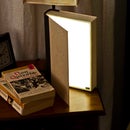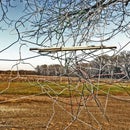Introduction: Edge Lit Displays
Do you ever need a cheap, quick way to make an impressive display? Do ever want to show more than a blinking LED but want something easier to use than a LCD? Do you want to make light appear to hover in mid-air? Then give some thought to edge lighting.
At the last Maker Faire I had a bunch of interactive gizmos for people to play with, but one question I was asked more than any other was "How did you make those displays?" On the Rock Paper Scissors Playing Glove one small display showed three different images and text while on the Secret Knock Detecting Gumball Machine the light just seemed to float in the clear plastic without an obvious source. The answer is edge lighting.
Edge lighting exploits a fun property of light called internal reflection where light can get trapped inside a transparent material. It's the same concept that makes both a diamond sparkle and optical fibers work. But we’re going to use it to make light come out of a sheet of plastic.
Simply put we shine a light in the edge* of a clear piece of plastic and etch it where we want the light to come out. With this simple, cheap method you can use a single LED to display words or images. Because it's etched into a transparent surface the images can seem to float in mid air or you can layer several of them to make a single display with more than one image or color.
Keep reading to see how easy and quick it is to get this effect.
*And thus the name "Edge Lighting"
Step 1: Credits and Theory
Please check out all the annotations on the images. There is useful information in them.
Credit:
First I need to give credit where it's due. This idea is not new or original. At very least it was used in calculators in the 60's. I was turned on to it by the always creative Evil Mad Scientist Labs and their great Christmas cards. They also did the research and found great materials which make the whole process easier
Theory:
When light passes between two different materials (like plastic and air) at a very high angle it will get reflected back rather than passing through. You can see this in a glass of water. Look at it from above and you can see right through it. Looking at it almost edge on and it will be very reflective. This means that if we shine a light into the edge of clear plastic the light will bounce around inside until it finds a way out. By etching and/or carving the surface of the plastic we control where it escapes.
Step 2: Materials and Tools
- You should be able to wire an LED to light up and not burn out.
- You should be able to use a rotary tool with some precision without causing irreparable damage to yourself or others.
Materials and Tools:
- Clear plastic. I recommend this polyester sheeting from McMaster-Carr. (Thanks EMSL!) CD cases will also work, but they tend to chip and crack.
- LED(s) 3mm or 5mm, any color, though the brighter (more mcd) the better. The white one used in this tutorial is a 6000 mcd 3mm.
- Power source for LED. If you don't know how to power an LED use this calculator to find out. You can also use a CR2032 button battery.
- Rotary tool A Dremel or similar with a fine grinding bit to carve or etch your plastic. A needle or craft knife will work in a pinch. If you're using acrylic you can laser etch, but the polyester sheets will just melt. CNC mill would probably work great.
- Craft Scissors (aka: Not the good scissors) To cut the clear plastic. A saw, hobby knife, or rotary cutoff disc can work too. (Don't use scissors on CD cases or other acrylic, or it will crack.)
- Aluminum tape Usually sold in the hardware store in the HVAC department to seal ducting. You can also use plain black electrical tape, but your display will be dimmer.
- Safety equipment. Yeah, I know, it's no fun, but eye protection is a must when using power tools. And I recommend a breathing mask too.
Time:
- About 10-30 minutes, depending on your tools, materials, and the complexity of your design.
Step 3: Make and Etch Your Design
First:
Figure out what you want your design to look like. If it's complex, like words, you might want to print it out rather than draw it freehand. However print them backwards (mirrored left to right). This is because we're going to etch the back of the plastic, not the front (it will be brighter this way) and we don’t want our words to come out backwards.
Second:
Cut your plastic to size. You can cut it to any size you want but allow at very least 8mm (3/8") on one of the sides--this is the side where we're going to put our light. If you're using polyester sheets you can use scissors to cut. If you're using acrylic sheets it's best to use a power tool with a blade meant for acrylic to avoid chipping.
Third:
Put your design on the front of the clear plastic for reference. If you're doing it freehand, you can stick some clear tape on the front and draw it. (Or many plastics come with a protective layer that you can draw on with a marker.) Otherwise tape your printout in position so you can see it from the back and use it for reference.
Fourth:
Etch your design. We use a Dremel with a fine round carving tip at about 10-15,000 RPM and etch to a depth of about 1/2 the thickness of the material. You can also use a needle, knife, or file to mark your design, anything as long as you rough up the surface. (I've even tried sand paper. It worked but it came out very sloppy.)
Step 4: Shape and Apply Lighting
First:
Slim down an LED. We want to get as much light as possible from our LED into the plastic, so we're going to grind down the plastic shell of the LED to fit better. You can find rectangular LEDs that will be the right thickness, but we find they're rarely bright bright enough and come in limited colors. We used a rotary tool with a sanding cylinder, but you can use whatever works (sanding table, sand paper, grinding wheel, etc). 3mm LED's don’t need much modification, just a tiny bit off the front and back. Be more careful when working with 5mm LEDs since you can accidentally go through the plastic case and remove some of the more important bits of the LED. Work slowly and carefully holding the LED in a pair of pliers to save your fingers. You can also shorten the height of the LED since we don't need the lensing effect of the case.
Second:
Wire up your LED. This depends the details of your project. If you're soldering it will be a lot easier and safer to do it now rather than when it's embedded in the plastic. It's also a good chance to make sure you didn't damage the LED when grinding it to size
.
Third:
Cut a place for the LED in the plastic. Use your rotary tool (or a file, etc) to carve a cutout along the edge the same size as our LED. It should fit snugly with only the wires sticking out. If you're using really thick plastic you can even drill holes in the edge to hold the light.
Fourth:
Hold the LED in place with aluminum tape. Apply a thin strip of aluminum tape along the edge that contains our LED. Make sure it runs on the front and back of the plastic. Cut out a notch around the LED wires so the metal on the tape doesn't short it out. The aluminum tape will not only hold the LED in place but will direct as much light as possible back into the display.
Apply some more reflective tape along the remaining edges. This is optional, but it will improve the brightness of the display and keep light from leaking out.
If you're not satisfied with the brightness of your display add more LEDs along the edge. Very long or large displays will be more evenly lit if you spread the LED's along the edge.
Step 5: Other Applications + Get a Patch!
Taking it further:
Lets say we're making an electronic Tic-Tac-Toe game. Ideally we want either an X or an O in the same place. To do this we make and X and an O with a separate LED for each one. Since each piece is essentially transparent when off, we can put one behind the other to have a display that can show an X or O in the same space, depending on which LED we light. You can also use the same effect to add more than one color to the same display or animate parts of an image like some animated neon signs.
Show me what you've done and get a patch!
If you make this Instructable, post a photo of it in comments and I'll send you a Master of Edge Lighting achievement patch and you'll get your name on the Hall of Fame.













